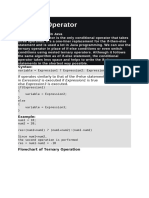0 ratings0% found this document useful (0 votes)
48 viewsOperator precedence in python
Uploaded by
Maaz AnsariCopyright
© © All Rights Reserved
Available Formats
Download as DOCX, PDF, TXT or read online on Scribd
0 ratings0% found this document useful (0 votes)
48 viewsOperator precedence in python
Uploaded by
Maaz AnsariCopyright
© © All Rights Reserved
Available Formats
Download as DOCX, PDF, TXT or read online on Scribd
You are on page 1/ 3
In Python, operators have a specific order of precedence, which determines how
expressions are evaluated. Operators with higher precedence are evaluated before
operators with lower precedence. Here's the order of precedence from highest to lowest:
1. **Parentheses**: `()`
Used to override the default precedence and explicitly specify the order of evaluation.
2. **Exponentiation**: `**`
Evaluates from right to left.
3. **Unary Operators**: `+`, `-`, `~`
Unary plus, minus (negation), and bitwise NOT.
4. **Multiplication, Division, Modulus, Floor Division**: `*`, `/`, `%`, `//`
5. **Addition, Subtraction**: `+`, `-`
6. **Bitwise Shift Operators**: `<<`, `>>`
Left and right shifts.
7. **Bitwise AND**: `&`
8. **Bitwise XOR**: `^`
9. **Bitwise OR**: `|`
10. **Comparison Operators**: `==`, `!=`, `>`, `>=`, `<`, `<=`, `is`, `is not`, `in`, `not in`
11. **Boolean NOT**: `not`
Negates a Boolean expression.
12. **Boolean AND**: `and`
13. **Boolean OR**: `or`
14. **Assignment Operators**: `=`, `+=`, `-=`, `*=`, `/=`, `%=`, `//=`, `**=`, `&=`, `|=`, `^=`,
`>>=`, `<<=`
15. **Lambda Operator**: `lambda`
Used to define anonymous functions.
examples that demonstrate the precedence of operators in Python:
### 1. **Exponentiation vs Multiplication**
```python
result = 2 ** 3 * 2 # Exponentiation happens first
# Equivalent to: (2 ** 3) * 2
print(result) # Output: 16
```
### 2. **Multiplication vs Addition**
```python
result = 2 + 3 * 4 # Multiplication happens before addition
# Equivalent to: 2 + (3 * 4)
print(result) # Output: 14
```
### 3. **Parentheses Override Precedence**
```python
result = (2 + 3) * 4 # Parentheses change the order
print(result) # Output: 20
```
### 4. **Unary Minus vs Exponentiation**
```python
result = -3 ** 2 # Exponentiation happens before negation
# Equivalent to: -(3 ** 2)
print(result) # Output: -9
```
### 5. **Division vs Subtraction**
```python
result = 10 - 2 / 2 # Division happens before subtraction
# Equivalent to: 10 - (2 / 2)
print(result) # Output: 9.0
```
### 6. **Comparison vs Addition**
```python
result = 3 + 2 > 4 # Addition happens before comparison
# Equivalent to: (3 + 2) > 4
print(result) # Output: True
```
### 7. **Logical NOT vs AND**
```python
result = not True and False # NOT happens before AND
# Equivalent to: (not True) and False
print(result) # Output: False
```
### 8. **Bitwise AND vs OR**
```python
result = 2 | 3 & 1 # Bitwise AND happens before OR
# Equivalent to: 2 | (3 & 1)
print(result) # Output: 2
```
### 9. **Assignment and Arithmetic**
```python
x=5
x += 3 * 2 # Multiplication happens before assignment addition
# Equivalent to: x += (3 * 2)
print(x) # Output: 11
```
These examples illustrate how Python evaluates expressions based on operator
precedence, helping you understand which operations are performed first.
You might also like
- Daniel 2 and 7 - Equal or Not Equal - Charles Cooper100% (1)Daniel 2 and 7 - Equal or Not Equal - Charles Cooper22 pages
- 21cs15it Problem Solving and Python Revision Questions and Answers (2)No ratings yet21cs15it Problem Solving and Python Revision Questions and Answers (2)33 pages
- 21CS15IT PROBLEM SOLVING AND PYTHON PROGRAMMING QUESTIONS AND ANSWERSNo ratings yet21CS15IT PROBLEM SOLVING AND PYTHON PROGRAMMING QUESTIONS AND ANSWERS6 pages
- This Comprehensive Python Cheat Sheet Covers Everything You Need To Know To Get Started With PythonNo ratings yetThis Comprehensive Python Cheat Sheet Covers Everything You Need To Know To Get Started With Python185 pages
- Ex. No: 1 Date: Recursive Function For Tree Traversal and FibonacciNo ratings yetEx. No: 1 Date: Recursive Function For Tree Traversal and Fibonacci79 pages
- Practical List: No. Aim of The PracticalNo ratings yetPractical List: No. Aim of The Practical20 pages
- Assignment - 1: Problem Statement: Ans Algorithm Input Output ArrayNo ratings yetAssignment - 1: Problem Statement: Ans Algorithm Input Output Array3 pages
- WAP To Find The Sum of The Series S 1 + (3/2!) + (5/3!) + (7/4!) + ....... To NNo ratings yetWAP To Find The Sum of The Series S 1 + (3/2!) + (5/3!) + (7/4!) + ....... To N8 pages
- 2 Sem CE144-OOPC++ Practical List-19-20No ratings yet2 Sem CE144-OOPC++ Practical List-19-2015 pages
- Python for Data Science: Data Science Mastery by Nikhil Khan, #1From EverandPython for Data Science: Data Science Mastery by Nikhil Khan, #1No ratings yet
- Neo-Riemannian Theory for Generative Film and Videogame MusicNo ratings yetNeo-Riemannian Theory for Generative Film and Videogame Music9 pages
- Powerbuilder Enterprise: Installation GuideNo ratings yetPowerbuilder Enterprise: Installation Guide42 pages
- All You Need To Know About Legal Language and Legal Writing - IpleadersNo ratings yetAll You Need To Know About Legal Language and Legal Writing - Ipleaders12 pages
- MELT205 - LessonGuide - InterculturalCompetence - BandaNo ratings yetMELT205 - LessonGuide - InterculturalCompetence - Banda9 pages
- Personal and Interpersonal: Commander K V Subba Rao (Retired) Accredited Management TeacherNo ratings yetPersonal and Interpersonal: Commander K V Subba Rao (Retired) Accredited Management Teacher56 pages
- Name - Spotlight 7 Module 1. Test.: 1. Match The Words/phrases To Their DefinitionNo ratings yetName - Spotlight 7 Module 1. Test.: 1. Match The Words/phrases To Their Definition3 pages
- Lesson 22 - Profile of A Leader From The Book of ActsNo ratings yetLesson 22 - Profile of A Leader From The Book of Acts26 pages
- Jupyterlab: The Evolution of The Jupyter NotebookNo ratings yetJupyterlab: The Evolution of The Jupyter Notebook22 pages
- Triduum For The Episcopal Ordination of Bp. Rafael T. CruzNo ratings yetTriduum For The Episcopal Ordination of Bp. Rafael T. Cruz23 pages

























































































